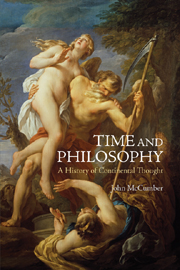Book contents
- Frontmatter
- Contents
- Acknowledgements
- Abbreviations and note on texts
- Introduction
- I Germany, 1790–1890
- 1 The collapse of Kant
- 2 Hegel discovers the past
- 3 Marx, capitalism and the future
- 4 Kierkegaard's dreadful future
- 5 Nietzsche and the boundless future
- II Germany and America, 1900–1968
- III France, 1945–2004
- IV Onwards, 2011–
- Further reading
- Bibliography
- Index
4 - Kierkegaard's dreadful future
from I - Germany, 1790–1890
- Frontmatter
- Contents
- Acknowledgements
- Abbreviations and note on texts
- Introduction
- I Germany, 1790–1890
- 1 The collapse of Kant
- 2 Hegel discovers the past
- 3 Marx, capitalism and the future
- 4 Kierkegaard's dreadful future
- 5 Nietzsche and the boundless future
- II Germany and America, 1900–1968
- III France, 1945–2004
- IV Onwards, 2011–
- Further reading
- Bibliography
- Index
Summary
One evening around 1850, a man named Otto Zinck had nothing to do. Zinck was a well known actor in Copenhagen, but this evening he had no performance scheduled, nor any party. As he was casting about for a way to spend the evening it occurred to Zinck that he might drop in on the brother-in-law of a friend of his, who had come to be his friend as well: Søren Kierkegaard. As Zinck approached Kierkegaard's luxurious apartment on the Nørregade, one of Copenhagen's most elegant streets, he must have wondered if he was doing the right thing. Even from the street he could see that the apartment, where Kierkegaard lived alone, was all lit up, as if for a party. Zinck went up anyway, and found Kierkegaard dressed in festive clothing – he was a very fashionable dresser – but completely alone. He was, Zinck decided, clearly waiting for his guests to arrive; and, not having been invited, Zinck promptly excused himself.
Kierkegaard would not hear of it: yes, Zinck must stay and chat a while; and no, he was not waiting for anyone. “I never have parties,” explained Kierkegaard, “but once in awhile it occurs to me to pretend that I am having one, and so I walk to and fro through the rooms, mentally greeting my imagined guests.” At that, Zinck wanted more than ever to leave, but he stayed for an hour, and was royally entertained by Kierkegaard's charm and wit.
- Type
- Chapter
- Information
- Time and PhilosophyA History of Continental Thought, pp. 77 - 96Publisher: Acumen PublishingPrint publication year: 2011



